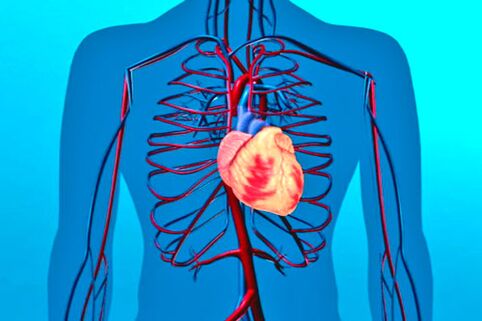
Risk factors for hypertension may vary depending on the type of disease. There are two types: primary or essential hypertension and secondary. The first type occurs many times more often than the second - it is diagnosed in 95% of patients with hypertension, and its development is associated with three groups of factors: general condition of the body, lifestyle and heredity. Secondary hypertension affects 5% of patients, and the risk factor for its development are various pathologies of specific organs. Some of the factors can be kept under control, reducing the risk of developing the disease.
Risk factors for primary hypertension
Essential arterial hypertension is a multifactorial disease; In some cases, it is impossible to accurately determine the cause of the increase in pressure. The danger of the disease lies in the fact that its symptoms do not appear immediately - the causes can harm health gradually, imperceptibly. Furthermore, even in a latent state, hypertension increases the risk of developing myocardial infarction and stroke.
health condition
One of the reasons for the development of hypertension is the deterioration of the elasticity of arterioles - small arterial vessels that transfer blood to capillaries. The condition of the vascular walls is influenced by several factors:
- aging of the body;
- sedentary lifestyle;
- heredity;
- inflammatory processes in tissues.
Blood composition is also important for vascular health. The weakening of the circulatory system is mainly associated with diabetes mellitus. Blood glucose levels are regulated by insulin, a pancreatic hormone. If its secretion is reduced or is unable to perform its functions normally, the vessels are more stimulated by the sympathetic nervous system than dilated under the action of insulin, which leads to an increase in blood pressure.
In addition to the condition of the blood vessels, the risk of hypertension is influenced by body weight. Obesity causes the body to require more blood, which increases the load on the heart and blood vessels. According to statistics, 85% of people suffering from this disease have a body mass index higher than normal. If obesity is combined with diabetes, this indicates a more complex metabolic syndrome - a metabolic pathology in which the destruction of blood vessel walls by cholesterol, triglycerides and glucose can lead to the development of atherosclerosis.
A risk factor for developing hypertension is also sleep apnea - interruption of breathing for 10 seconds or more during sleep. This happens with intense snoring, when the airways are completely blocked due to pathology of their structure or other reasons. Each respiratory arrest is a strong stress for the body and the pressure rises to 200–250 mmHg. Art. Regular attacks lead to chronic high blood pressure.
Lifestyle
An inadequate lifestyle is a group of risk factors that are easier to control to prevent the onset of diseases. These include:
- unhealthy diet, leading to an imbalance in the salt balance in the body;
- lack of physical activity;
- smoke;
- alcohol abuse;
- chronic stress.
Excessive consumption of table salt is a symptom that unites most people who suffer from high blood pressure; Risk factors for this include increased sodium concentration and low potassium. Salts affect pressure on both sides: they cause constriction of blood vessels and retain water in the body. As a result, both blood volume and pressure on artery walls increase. To avoid this, you need to eat no more than 5. 8 g of salt per day.
A sedentary lifestyle doesn't just lead to obesity. With a lack of activity, arrhythmia develops - the heart weakens and, in order to pump blood in the required quantities, it has to beat more often, which increases the load on the entire cardiovascular system. During exercise, hormones are produced that strengthen the heart muscle and relax blood vessels, which leads to a decrease in blood pressure.
Tobacco increases blood pressure regardless of whether it is smoked, chewed or snorted. The chemicals it is impregnated with destroy blood vessels. Nicotine has a complex effect on the circulatory system - it accelerates the heartbeat, increases the load on blood vessels and narrows the lumen of the arteries. Electronic cigarettes do not save you from this negative effect, although without the entry of carbon monoxide produced during the combustion of tobacco into the blood, the blood vessels will still be healthier.
Alcohol destroys the heart muscle, which leads to increased blood pressure. Women are recommended to drink no more than 0. 5 liters of drinks with an alcohol content of 5% per day, men - no more than 1 liter before the age of 65 and no more than 0. 5 liters - after the age of 65.
Stress causes disturbances in the functioning of the nervous system and leads to a complex deterioration in the functioning of the body, including affecting blood pressure. Furthermore, it is the backdrop for the emergence of bad habits - excessive eating, smoking and alcoholism, which directly increase the risk of developing high blood pressure.
Heredity

Family history is especially important in diagnosing hypertension; Risk factors, as a rule, are the general environment (ecological situation where the family lives) and behavior (lifestyle factors are likely to be transmitted from parents to children), but mainly genes. Heredity is considered the main factor in the development of high blood pressure: there are genes that cause an increase in the synthesis of renin, a renal hormone that increases blood pressure.
Hypertension is associated with heredity in 30% of cases, therefore it is important to monitor the family history and write down all diseases diagnosed in close relatives (parents, brothers and sisters, grandparents) - this will help assess the risk of developing pathology and prevent -there. If there is a risk, you need to control your lifestyle even more carefully.
Knowing all these factors, hypertension can be prevented by monitoring the development of prehypertension, a condition in which blood pressure is on the limit between normal and dangerous.
| state | Pressure values (mmHg) | |
|---|---|---|
| Systolic | Diastolic | |
| Standard | 120 | 80 |
| Prehypertension | 120–139 | 80-89 |
| Hypertension | >140 | >90 |
To detect the disease in time if you are at risk, or to monitor your health status in case of hypertension, it is recommended to measure your blood pressure twice a day: in the morning and in the evening, and also when you feel unwell.
Risk factors for secondary hypertension
If primary hypertension develops against the background of a general deterioration in the condition of the body and, in particular, the circulatory system, then the risk factors for the development of hypertension of the secondary type are specific diseases of the kidneys, endocrine glands and cardiovascular system .
Kidney diseases
The main renal pathology that leads to increased blood pressure is a decrease in the lumen of the renal artery. It may be congenital or develop at an advanced age. The main reasons for the intravital development of pathology:
- thickening of the smooth muscles of the artery - occurs in young women;
- atherosclerosis - in old age.
Due to this disease, blood flow in the kidneys worsens, resulting in increased secretion of renin and angiotensin. Together with the adrenal hormone aldosterone, they lead to an increase in vascular tone and blood pressure. To treat the pathology, the vessel is mechanically expanded and reinforced with a structure.
Also, changes in hormonal levels can be influenced by chronic pathological processes in the kidneys - pyelonephritis, the formation of stones in the bladder, etc. The opposite reaction can also occur - hypertension leads to diseases of the urinary system.
Adrenal tumors
Occasionally, diseases of the adrenal glands lead to increased arterial tone. These include the development of tumors that increase hormone production:
- Aldosteroma – produces aldosterone. In addition to hypertension, this also leads to increased potassium excretion from the body.
- Pheochromocytoma – produces adrenaline, which accelerates the heartbeat, leading to an increase in blood pressure. Additional symptoms are hot flashes, flushed skin and increased sweating.
In both cases, treatment consists of removing the adrenal glands.
Thyroid dysfunction
In the case of secondary hypertension, some risk factors may be some diseases of the thyroid gland: diffuse goiter, nodular goiter. They lead to thyrotoxicosis - an increase in the production of thyroid hormones. These biologically active substances regulate the body's metabolism; when they are in excess, the heart rate increases, which leads to an increase in blood pressure.
Taking medications
In addition to diseases, secondary hypertension can be caused by the use of various medications and other substances. These include:
- antidepressants;
- drops and sprays for rhinitis;
- anti-inflammatory medications;
- oral contraceptives;
- corticosteroids;
- narcotic substances - cocaine, amphetamines;
- hematopoietic stimulant;
- asthma medicines;
- Antihypertensive medications - when discontinued, they can cause a sharp increase in blood pressure.
If hypertension is caused by medications, you should consult a doctor and replace the medications you are taking with analogues with fewer side effects.
Other risks of developing the disease
There are othersrisk factors for hypertension. Unlike diseases and lifestyle choices, they cannot be eliminated or controlled.
One of these factors is race. Research shows that high blood pressure is more common and develops earlier in blacks than in whites, Hispanics, Asians and others.
The person's sex also influences – men have a higher risk of hypertension, especially in adulthood and old age. Women are at risk during menopause and during pregnancy. The risk increases with age in both sexes. If by the age of 29 the probability of developing the disease does not exceed 10%, then by the age of 60-69 it reaches 50%.
Most of the world's population is exposed to risk factors for hypertension at one time or another in their lives. In the United States, according to research, 9 out of 10 people contract the disease sooner or later and, in most cases, this is associated with an unhealthy lifestyle. Breaking bad habits, getting regular checkups with your doctor, and monitoring your blood pressure are the best ways to stay safe.






















